
A few ideas to improve stage scenery
From the age of 8, I was fascinated with the design and construction of stage sets. Theater transports its audience to a place within their minds that they might not ordinarily go. The set designer is able to create a fantasy environment on the stage. My parents were long supporters of the Dallas Summer Musicals. T. I would sometimes go with them - the first show I saw there was The Sound of Music.The shows were good, but I was mesmerized by the sets that painted the scenes and the mechanical ways of changing the scenery between scenes. I wanted to do that. The first show I designed was for my mother's dance group of folklore dances from Mexico. I became fascinated with model-making. In high school, I designed the sets for the school plays and musicals and productions at our church. Even when I was a teenager, I was making connections, seeing possibilities, and noticing ways to make things better. Below are a few ideas I developed and sketched from 1966-69.
Self-storing pyramid steps
My mother created a dance group that specialized in folklore dances from various regions of Mexico. She asked me to design some simple stage sets that could easily travel as the group performed around Texas. These included an Aztec ritual area, wing flats, a forest/jungle with trees, and cactus. One number was an Aztec god dance. It needed a pyramid and a set of steps for the plumed god, Quetzalcoatl to ascend. I built a canvas flat in the shape of a pyramid that folded in half to protect the canvas and to make it easier to transport. In front of that were three steps that I built out of scrap lumber. I was still learning about structural support and would add wood where necessary to support human weight. It didn't tour well and was cumbersome to cart around.
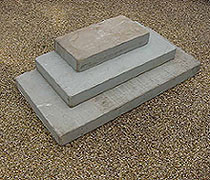
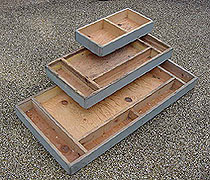

I designed a set of 3 steps that would nest inside of each other when inverted yet provide ample support when set up. I built them out of 1x4 lumber and half inch plywood to keep the weight down for easy storing and carrying. It worked - simple solution to a set of 3 steps that would be easy to transport. The pictures above were taken years later, after they had sat in the garage and weathered a bit.
Design and production: 1966
Platform components
Stage sets consists of 3 main components: flats and vertical set pieces, drops and pieces flown in from the loft, and platforms that change the height of the acting floor. There are 3 main types of platform legs. The parallel was a rectangle/parallelogram that opened to fit the corresponding size platform top. The downside is a theater needed lots of these braces - to fit a variety of platform tops. I noticed that if, instead of 1 piece, there were 2 or 3 that fit each end of the platform, the legs could fit several sizes of tops. Advantages:
• Sturdy
• Easy to set up and strike
• Flexible - rearrange legs underneath top
• Less abuse of lumber and set pieces
• Cheaper - uses less lumber
• Less space required for storage


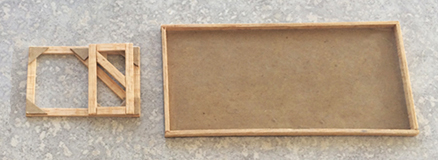
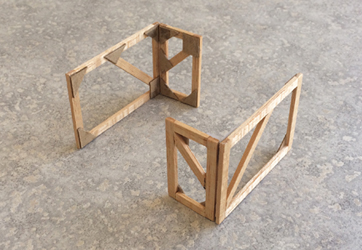
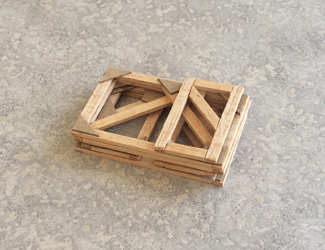
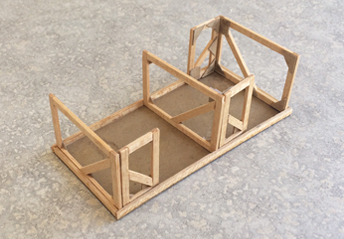
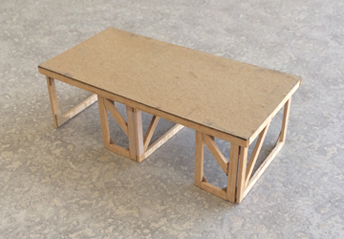
Flat support hardware
The standard way to attach flats (in 1968) was to use a loose-pin hinge. This allowed the pin to be removed easily so the two flats could be separated, moved, and stored. I wondered about using hard plastics, instead of metal, and a male-female pin arrangement that didn't rely on a separate pin. Plastic is more 'forgiving' and has a smooth surface for sliding in and out. The tapered end of the male pin and the funnel opening of the females allowed easier operation in set up and strike.
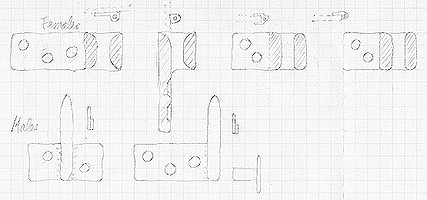
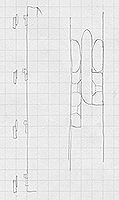

Dutchman hinge
Canvas across the opening hides the crack between sections when open.
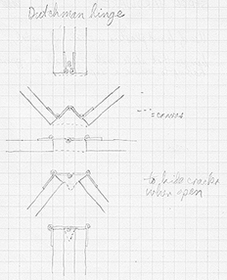
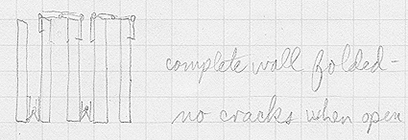
Collapsible column
Wood lengths are supported with opposing hinges - when opened and folded over, form a rigid support. When hinged shut, collapse into a smaller package for moving and storage.
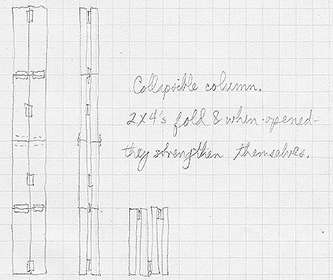
Components for a Color Light Machine system
The color light machine is a system of fixtures, gels, dimmers, and cords to use in classroom activities to demonstrate various properties of light, color, and color mixing. The fixtures, gel frames, and gels in the prototype were purchased at Little Stage Lighting Company in Dallas. The other components were purchased at a hardware store. The total cost for the system (in 1982) was $410.00.
All electrical components in the system operate on 120 volts. Each fixture has a 250 watt General Electric Quartzline light bulb lamp, a 52" cord with ground cable and three-prong plug, and a 6.5" x 11.5" wood base. Each of the three units has a frame holder that will accept 6.5" frames or an extension unit that has a focusing system, a pattern or gobo slot, four shutters for altering the size of the light beam, and a frame holder that will accept 4" frames.

There are four 6.5" frames with one each of blue, green, red, and yellow; four 4" frames with the same four colors; and three sets of gobos, each consisting of round holes decreasing in size from 1.75" to .5".

Three dimmer controls each capable of handling 600 watts (no more than 2 of the light fixtures), four 3-prong female outlets (1 wired to each of 2 dimmers and 2 wired to the third dimmer), one 3-prong male outlet, and mounted in a 13.5" x 7" x 1.75" wood box.
Four electric cords, each 15 feet long, each capable of carrying 1625 watts, with a 3-prong female plug on one end a 3-prong male plug on the other. One multiple plug with three 3-prong female outlets and one 3-prong male outlet.
Arrangements of the Components
These sketches show some of the many possible configurations of the components of the system.


Advantages of the system
The separate cords, plug, and control box allow for a variety of uses and configurations. The total cord length is 60' to allow for convenient placement of the light fixtures. The fixtures can be positioned to aim in any direction and can sit on any flat surface.
All plugs are standard household 3-prong plugs' there are a minimum of parts, and the light fixtures are on flat bases.
The gel frames, gobos, and shutters are easy to manipulate. The dimmer controls are color coded and calibrated for easy positioning. The lamps have standard size screw-in bases for easy replacement.
The entire system, except for the three light fixtures, can be packed into a 12" x 12" x 18" cardboard box.
Classroom Activities Using the System
The color light machine can be used for a variety of activities in the art or design classroom. Creative teachers can explore even more possibilities than the examples listed here.
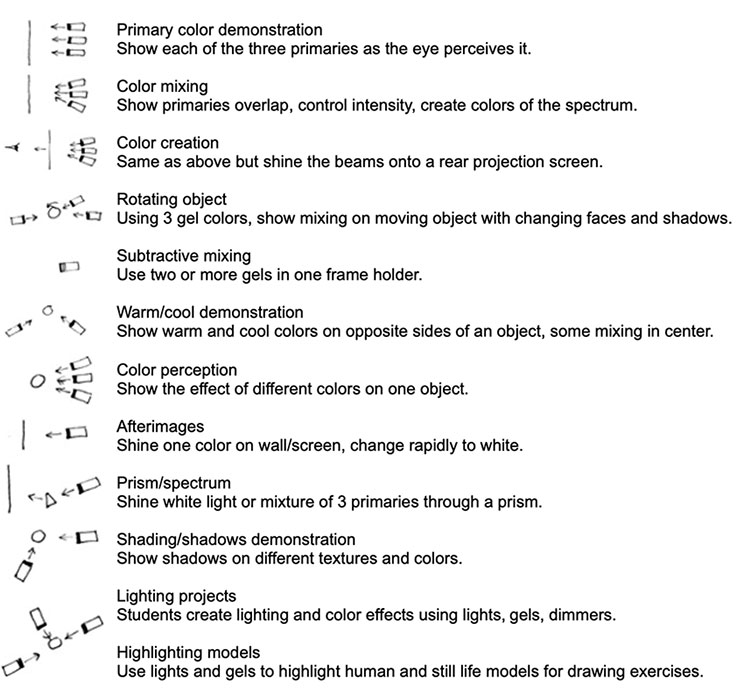
Sketches
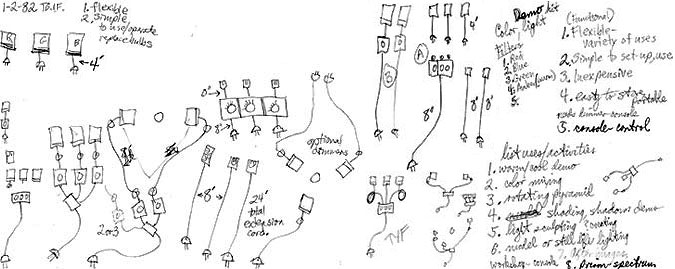
Dates: Concept, design and sketches: December 1981 - January 1982
Set designs Jim did in high school
Set designs Jim did in college
www.jamesrobertwatson.com/design-stageset.html